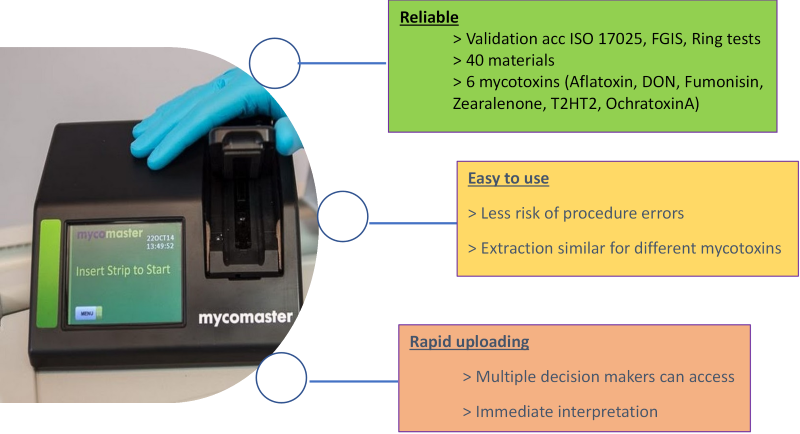Lab assessment for raw material quality control
Niwas Balaji, Laboratory Manager, Trouw Nutrition India Pvt Ltd

Quality control of incoming feed ingredients is the heart of quality feed production. Many raw materials are considered whilst production of animal feed basis their chemical composition, availability, quality, and current price structure. The raw materials utilized in feed production can differ in composition based on variations in processing techniques, such as oil extraction, polishing etc. Due to the high volatility in raw materials, adulteration has been a common practice. It is, therefore, crucial to chalk out specifications for procurement of standard raw materials and ensure that the incoming raw materials comply with these standards. Sampling of material for analysis should be such that it represents the entire consignment. Otherwise, the whole purpose of quality control will be defeated, as the quality of produced feed will be no better than the qualities of the individual ingredients used in the formula. Hence, it is essential to possess a good laboratory (lab) and tools, to practice stringent quality control measures for ensuring optimal quality of raw materials.
- Evaluation of feeds and feed ingredients for quality
They are in general subjected to various tests as mentioned below:
- Physical evaluation – ON THE SPOT – FEED MILL
- Chemical evaluation- LAB
- Microscopic Evaluation - LAB
1.1. Physical evaluation
It is the crudest way of evaluation, which is relatively easier to carry out. Said that, one must be highly trained to identify the variations in the nature of the raw materials/feeds.
Colour
This is the foremost quality parameter to be judged. Any colour change can possibly indicate contaminations, grain maturity, processing conditions, etc. Aberration in colour might also be an early sign of compromised nutritive value.
Size
Overall, the size of the grain governs its energy value due to the proportional decrease/increase in seed to coat ratio. Smaller the grain, lower will be the metabolizable energy (ME) value due to more proportion of coater hulls. To evaluate the cereals, weight of a fixed number of grains usually 100 grains or fixed volume is taken. Higher weight indicates a higher ME value. This technique is called Test Weight.
Uniformity
The raw materials to be selected should be uniform in composition. The presence for contaminants like other grains, husk, broken grains, weeds, infected seeds is viewed. In the oil seed cakes, closer observation can reveal the presence of fibrous material, if contaminated. For micro-ingredients, such as premixes, homogeneity is with respect to free-flowing nature of the material.
Smell
Smell is one of the best indicators of quality. Just standing near the stock itself will immediately indicate any difference in the normal smell. This skill is developed over years of experience. For e.g., Musty odour could possibly be due to fungal growth and contamination or weevils. Oil and oil rich ingredients can be subjected to this method of evaluation, for rancidity. Odour of petroleum products could be suggestive of excessive pesticide or fungicides usage.
Taste
Each ingredient has a peculiar taste, any deviation such as bitterness in grains and oil seed cakes could be indicative of presence of moulds/mycotoxins. The level of salt can be detected by tasting the ingredient and the feed. Bitter taste of rice polish points to rancidity of fatty acids.
Touch
Touching the raw material roughly indicates the moisture content. Chilliness indicates high moisture content. Lumps can be felt by moving the hand inside the raw material/feed bag, which could be formed due to high moisture content, improper storage, improper cooling etc. Lumps can be either hard or soft, depending on various factors.
Sound
Dry grains on pouring down or biting will produce sound of spilling coin.
1.2. Chemical evaluation
An analytical laboratory for precise estimation of nutrient composition and undesirable contaminants is of utmost important. The feed ingredients and finished feeds should be analyzed for proximate principles. Low crude protein (CP) and high crude fiber (CF) of oil seed meals could indicate adulteration with fibrous materials. A strange CP value (high) could be suggestive of adulteration with urea and/or some inferior quality oil seed meals. The amount of acid insoluble ash is a good guide to the presence of sand or other dirt. It is also desirable to determine free fatty acid content of oily materials as this will affect palatability.
Chemical evaluations, if carried out in a prompt way, using rapid on-site tools, can enable the producers to take informed and quick decisions, with respect to quality of feed ingredients/feed. The NutriOpt On-site Advisor from Trouw Nutrition is one such tool, that enables rapid and reliable assessment of the nutrient content (Fig. 1). Mycomaster, is another tool kit from Trouw Nutrition, that gives an accurate measurement of the mycotoxin load in various feed ingredients/feed, as shown in Fig. 2. The “MyNutriOpt” web portal, gives further insights of the raw materials, with respect to extended nutrients, mycotoxin risk management etc. (Fig, 3)
Fig. 1: NutriOpt Onsite Advisor

Fig. 2: Mycomaster

Fig. 3: MyNutriOpt

1.3. Microscopic Evaluation of Animal Feed:
Feed microscopy is commonly used for confirming the adulteration and identifying the adulterants (AOAC, 1970). Feed ingredients, adulterants and contaminants must be studied under low and high magnification for distinguishing features whether coarsely or finely ground. Physical characteristics such as shape, colour, particle size, softness, hardness, and texture of the feeds are examined at low magnification of 8x to 50x. It is a useful method to identify impurities/contaminants and evaluating the quality of feed ingredients. It also serves as a useful method for identifying missing ingredients in finished feed.
The plant cells and structural features of the feeds are observed at high magnification of 100xto 500x.
A feed scientist must be familiar with various feed ingredients and adulterants and must have a collection of pure feed ingredients, adulterants, and contaminants for accurate and fast quality assurance results.
- QUALITY CONTROL DURING STORAGE
Feed ingredients if not stored properly, may deteriorate the nutrient content and thereby the quality of produced feed. These changes could be physical, chemical or biological, depending on environmental and storage conditions.
Physical changes would lead to changes in colour, texture, odour of raw materials. Chemical changes would lead to alterations in proximate content and other extended nutrient profile. Biological changes in general exhibit themselves as infestation with weevils, microbes etc.
Use of damaged food grains for feed:
|
Sr. No. |
Class |
Sound/slightly damaged/touched & broken grains % |
Category for which declared fit |
|
1. |
Feed-1 |
70-85 |
Poultry |
|
2. |
Feed-2 |
55-70 |
Cattle |
|
3. |
Feed-3 |
30-55 |
Industrial |
|
4. |
Manure |
10-30 |
Manure |
|
5. |
Dumping |
4-10 |
Dumping |
As per the quality control manual of FCI the damaged food grains are classified into five categories as depicted below,
To summarize, apt quality control of raw materials and finished feed, plays a crucial role, with respect to the optimal and precise nutrient delivery, as per the species needs. A good quality control laboratory with strict SOPs needs to be planned and implemented, for quick judgment of feed ingredients’ quality. Rapid tool kits need to be deployed to take speedy informed decisions, to enhance the productivity and profitability of animals and producers, respectively.
For further information, kindly write to us at customercareindia@trouwnutrition.com